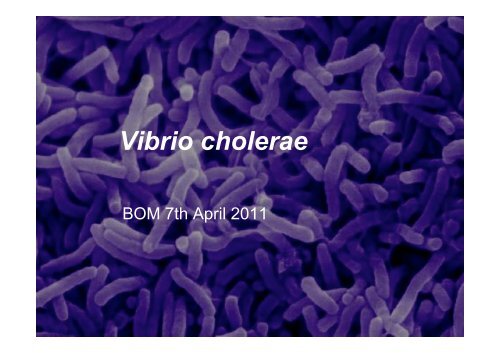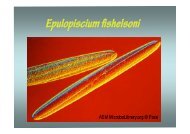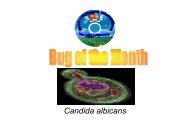Vibrio cholerae.pdf - Academic lab pages - School of Biosciences
Vibrio cholerae.pdf - Academic lab pages - School of Biosciences
Vibrio cholerae.pdf - Academic lab pages - School of Biosciences
You also want an ePaper? Increase the reach of your titles
YUMPU automatically turns print PDFs into web optimized ePapers that Google loves.
<strong>Vibrio</strong> <strong>cholerae</strong><br />
BOM 7th April 2011
Why <strong>Vibrio</strong> <strong>cholerae</strong>
The infection<br />
• Cholera<br />
• Varies from mild to sever diarrhoea<br />
• “rice water stools”<br />
• Onset usually sudden<br />
• 2 hours to 5 days incubation<br />
• Symptoms<br />
Abdominal cramps, nausea, vomiting,<br />
dehydration, shock, severe fluid and<br />
electrolyte loss
The infection<br />
• Estimated 3–5 million cholera cases and 100<br />
000–120 000 deaths due to cholera every year.<br />
• Most asymptomatic (75%)<br />
• <strong>of</strong> those that become symptomatic 80-90%<br />
mild symptoms<br />
• 20% will develop severe diarrhoea and show<br />
typical cholera dehydration<br />
“Almost every developing country faces cholera<br />
outbreaks or the threat <strong>of</strong> a cholera epidemic.”<br />
(WHO)
<strong>Vibrio</strong>, the bug…<br />
•Gram-ve<br />
•Curved rod<br />
•Single polar<br />
flagellar<br />
•Proteobacteria<br />
•Found in<br />
•contaminated<br />
water systems<br />
•Raw shell fish<br />
Serogroups O1 and<br />
O139
Cholera Toxin<br />
CT<br />
• Carried on a non-lytic bacteriophage in<br />
chromosome<br />
• 80% AA identity to ETEC heat <strong>lab</strong>ile toxin<br />
(LT)<br />
• 2 subunits<br />
• 1 x Heavy (A) = Active/toxic<br />
• 5 x Light (B) = cell binding<br />
•Export via T2SS<br />
• Binds ganglioside GM1 and is endocytosed<br />
•CTA released into cytosol - denylate<br />
cyclase AMP a uptake water<br />
secretion
More virulence factors<br />
• Toxin coregulated pilus (TCP) tcpA<br />
• Adherance and colonisation <strong>of</strong> small intestine<br />
• Mannose-sensitive Haemagglutinin pilus<br />
(MSHA) mshA<br />
• Lux quorum sensing<br />
• Regulates virulence factor transcription via HapR and<br />
AphA<br />
• High cell density ↓ expression CT and TCP
Bile<br />
σFliA – also<br />
represses HapR<br />
Gastic Acid<br />
luxO P<br />
HapR represses by srRNAs<br />
AphA able to induce TCP and<br />
CT expression
Treatment<br />
• Oral Rehydration therapy – Successful for<br />
80%<br />
•Sodium chloride, glucose, potassium<br />
chloride and citrate<br />
• Intravenous fluids for the most severe and<br />
antibiotics (tetracyline)<br />
• Antibiotic use kept to a minimum
Treatment - vaccines<br />
• Two types <strong>of</strong> oral cholera vaccines<br />
• Both are whole-cell killed vaccines<br />
• one with a recombinant B-sub<br />
• one without.<br />
•Both have sustained protection <strong>of</strong> over 50%<br />
lasting for two years in endemic settings.<br />
•Dukoral = B-sub, WHO prequalified and<br />
licenced in +60 countries, high protection but<br />
short term<br />
• Vaccines provide short term protection<br />
improving water and sanitation is required<br />
for long term protection <strong>of</strong> communities.





